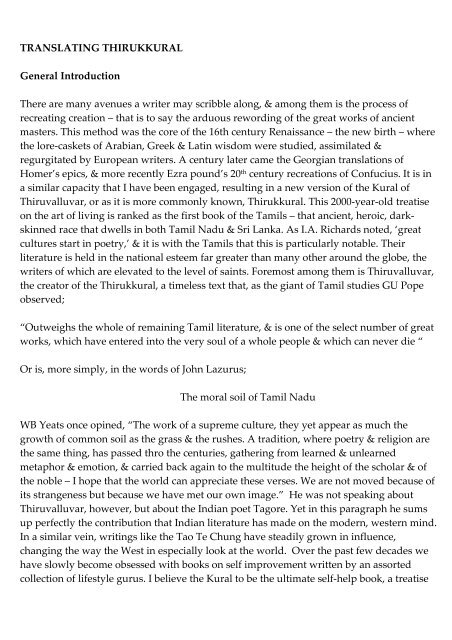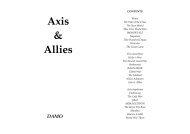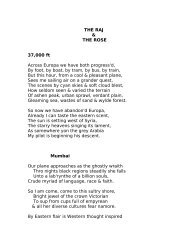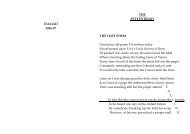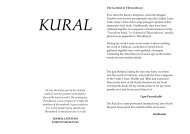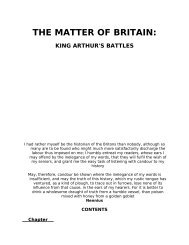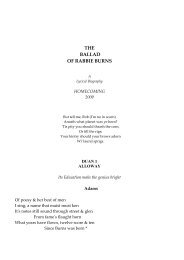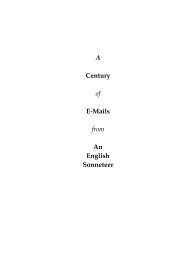Translating Thirukkural.pdf - damowords
Translating Thirukkural.pdf - damowords
Translating Thirukkural.pdf - damowords
You also want an ePaper? Increase the reach of your titles
YUMPU automatically turns print PDFs into web optimized ePapers that Google loves.
on the unchanging realities of human existence, tracing through its pages the outline of anideal life.As we stride through the twentieth century, a new culture awaits mankind – that of aunified ‘global village,’ needing its own ‘international literature,’ & the non‐sectarian, antinationalistic<strong>Thirukkural</strong> fits the bill astonishingly well. To the Tamils, the <strong>Thirukkural</strong> is adivine book, but not in the sense of the Koran or Bible, which offer an obstinate outlook onthe religious experience. Over the centuries it has been observed that people are morewilling to die for their scriptures than to live by them, but the <strong>Thirukkural</strong> is simply a bookto live by, a code of moral conduct to which all creeds, castes & colors can connect, whoselofty idealism has been acclaimed by all the religions of the world. In the words of EVDaniel, “The Holy Kural may well be the meeting ground, the common ground, of allreligions.” Every sect & faith can see their own god through Vallavur´s portrayal of auniversal deity, without all the bias that is inherent in classical religions. There are nomyths, no miracles, no Apocalypse, no global mission, no ´god above all others.´ Nor arethere pantheons of myriad‐minded gods – there is only one, although Thiruvallavardoesn’t actually provide a name. I believe this ultra‐wise ascetic saw the pointlessness ofsectarianism, as whichever faith you belong to, God is just God. Recognizing & sharing thissentiment, during the translation I have replaced the word ‘God’ with ‘Faith,’ for after all,isn’t the belief in an existential, omnipresent being merely faith in one’s spiritualconvictions.<strong>Thirukkural</strong>Like the other great Vedic literatures, the Ramayana & the Mahabharata, <strong>Thirukkural</strong> is anepic. However, here the heroes are not princes & kings, nor are there any battles betweendemons or massive, monstrous armies. Instead, the star of the poem is the common man, &Thiruvalluvar tells his story through the many experiences that a lifetime would affordhim; through friendship & love to statecraft & begging. The full magnitude of theachievement can be realized on a cursory glance through the text, where the multifacetednature of mankind is so fully explored. The Kural is not a book of rules, laws orcommandments. EV Daniel noted, “There are no ‘thou‐shalt‐do this and thou‐shalt‐not‐dothat.’ The Kural is a book with sharp observations of real life, a deep understanding ofhuman weaknesses and strengths, and wise suggestions as to how we can live up to ourfullest capacities as free human beings.”What are the Kural? In Tamil, the word Kural means ‘dwarfish,’ & has been applied to theshortest measure in Tamil poetry – the Kural Venba. This is a couplet of only seven words –
four in the first line & three in the second. This curtness insists on an epigrammatic natureof composition, such as the English proverb ‘A stitch in time, saves nine.’ The kural areinherently simple, yet extremely subtle, being very similar to the Japanese Haiku, whereideas & sensations are expressed with a modicum of words. Yet in the hands of Valluvar,through the act of ellipsis, he condenses his world‐view into phenomenal couplets thathave become became sharpened knives with which to unstitch the fabric of mortalexistence & expose it to the world. Or as Archbishop Trench remarked;“He abounds in short and memorable, and, if I might so call them, epigrammatic sayings,concentrating with a forceful brevity the whole truth which he desires to impart into somesingle phrase.”What he has achieved is no less than a blueprint for life. & these neat, ordered rows ofkural have stamped an order on the chaos of human existence. Or as Reverend P Percivalonce wrote, “Nothing in the whole compass of human language can equal the force andterseness of the couplets in which the author of the Kural conveys the lessons of wisdom.”Two thousand years have passed since the Kural were first written down, but theirmessage still resonates loudly through a human condition that seems eternally imperviousto change. That there is in each kural a direct & corresponding emotion, event or fact, atlarge in the modern spirit, is a perpetual wonder of the basic activity of the human soul.Part of the delight in the Kural is the fact that most of them seem instantly recognizable tous, resonating with a inner understanding of life that we all hold deep within our psyches.The ancient Greek philosopher Plato called this ‘Anamnesis’ – that all learning is simply arecollection from a previous birth. He says that experiences gained in a former life can betaken forward into the next, a starting point if you will, in order that we can evolve evenfurther as human beings. This ‘Innatism’ says that we are all programmed with certainkinds of knowledge that the kural one‐by‐one expose to our upper consciousness. Each oneof these timeless teachings unlocks a tiny portion of the mysteries of the universe & as theyare embraced by the willing student, a larger picture of the human condition shall slowlybe surveyed. The Tamils say that following just a single kural will make us a better person.Then if the whole world were to do the same; as billions of raindrops make an ocean, so theabsorption of many individual kural into the global psyche must form an ocean ofgoodness to cleanse the spirit of the world.Tamil’s & the Kural
Over the centuries the Kural have become a much‐quoted fibre of the Tamil fabric, theirquintessential guidebook for life. They are heard in the speeches of Indian prime ministers,they can be seen written above the driver’ seat on most of the buses that range Tamil Nadu& they can be felt in the manners of every Tamil. The popularity of <strong>Thirukkural</strong> must comefrom its vivid & easy to remember couplets, which lend themselves quite readily tomemory & recitation. Nowhere else in the world is such a vast amount of worldlyknowledge stored within such a short, aesthetic & musical form. It is for this reason that theTamils consider themselves to be blessed among the peoples of our planet, or asShudhannanda Bharati wrote, “The outstanding greatness of Tamil Nadu was that it gaveValluvar to the world”The people of Tamil Nadu worship Thiruvalluvar as a saint, the universal guru of theirlives. Each year, on Thiruvalluvar day, they celebrate him with a public holiday. Theyhave erected a beautiful shrine to him in the midst of a garden in Mylapore, every yearcelebrating a great festival there. In nearby Chennai they have erected the Valluvar Kottam,shaped like one of the great temple chariots the Indians wheel through the streets onfestival days. A life‐size statue of Thiruvalluvar has been installed within & all 1330 kuralare depicted in bas‐relief at its base. The greatest physical monument, however, is themagnificent 133‐foot high statue of the saint stood majestically off the shores ofKanayakamari, the most southern point in India. It was dedicated at the dawn of the newmillennium (1.1.2000), & stands like some spiritual lighthouse watching over the world.To exemplify how the Tamils consider their national book, I found nothing better than aninspired speech made by Gurudeva, HH Sivaya Subramuniyaswami, on SaintThiruvalluvarʹs Guru Puja Day, February 15, 1979;The Holy Kural should be used in everyday life ‐ its verses committed to memory andmeditated upon, quoted freely as your very own. You will sound wise if you do rememberand share these jewels.One of the greatest benefits of this scripture is to guide our actions and our thoughts, todirect our purpose in life and refine our interactions with our fellow man. Problems can beresolved in the light of the saintʹs wisdomThat is perhaps its main function ‐ to perfect and protect our lives in the everyday world bypreventing mistakes which can cause an unhappy karma, by preventing erroneousattitudes which can bring unnecessary sorrow into our experience.
It can be our refuge in times of confusion, a source of inspiration when we feel less thaninspiredSmall children all through South India memorize the Holy Kural in order to be able tochant it verse after verse ‐ many can recite the entire 1,330 verses by heart.This gives them a code of living that remains with them the rest of their lives. It is crucialthat children be given the benefit of strong principles from an early age, especially in thesetimes when television and the stories, plots and scenes that children see on televisionwhich form the code of living for their lives provide opposite and obscure values.ThiruvalluvarThiruvalluvar can be seen as the ideal man; being a poet, scholar, lawgiver, oracle, socialthinker, ethicist, psychologist, political scientist, experienced lover & containing in his ownsoul the soul of mankind. The word Valluvar itself means ‘priest of the weaver of thePariah class,’ one of the lowest castes in India. It is interesting to compare this birth statuswith that of Jesus Christ, who himself was a low‐born son of a common carpenter. Theword ‘Thirru’ is the equivalent of ‘Sri’ in Hindi, & means ‘Lord’ or ’Holy.’ ThenThirruvalluvar mans ‘Very holy priest of the weaver of the Pariah caste.’ The general beliefis that he was born in Thirumailai, near Mylapore, Chennai. There is evidence to show thathe at least died there, for there is an ancient shrine dedicated to him at Mylapore, for it is aTamil tradition to build a shrine at the place where a great individual passed away. That heis considered to come from Mylapore is also very exciting. This is the one spot in Indiaassociated with the apostles, & Saint Thomas was presumed to have died there, the samesaint who had been an original witness to the Sermon on the Mount. Scholars have found anumber of parallels between these very teachings of Jesus & the Kural. Compare these twoaphorisms;Whoever looks at a woman to lust for her has already committed adultery with her in hisheart (Matthew 5‐28)Ignoring other womenʹs womanlinessCrowns worthy husbands (<strong>Thirukkural</strong> 15‐7)
History of the KuralIt is an interesting fact that the text the world knows as <strong>Thirukkural</strong> was given its name at amuch later date than its composition. There are no records extant that claim a title for bothwriter & text, but what we have are simple legendary names. It is as if the Kural wasdeposited on the shores of Tamil Nadu by some divine creature, & left to do its sacredwork. This is not uncommon in Tamil literature, as DR Caldwell noted,“Tamil writers, like Hindu writers in general, hide their individuality in the shade of theirwritings. They seem to have regarded individual existence as worthless & absorption intothe universal spirit of the classical literature of their country, as the highest good to whichtheir compositions should aspire.”The jury is still out on when the Kural were actually composed. Many Tamil scholarsregard it as a second century work, while the Europeans have dated it much later, to aboutthe eighth century. The earlier date is probably the more correct, as it wasn’t until the sixthcentury AD that sectarian bitterness swept through south India. Until that time the variousfaiths lived happily & tolerantly together, & the non‐sectarian Kural may reflect this. Yetagain, perhaps Valluvar wrote his treatise as a counterpoise against the chaotic times ofsectarian feuding. The question is indeed a thorny one, but then the beauty of the Kural isthe fact that there can be found hardly a clue as to its date of composition. This simply addsto the timeless universality of the book, which is, in effect, speaking to men of all ages.Many scholars have noticed the echoes & traces of the great books of wisdom that wereextant in Thiruvalluvar’s day. Two thousand years ago Tamil Nadu was a great maritimehinge between the trade of China & Rome. Through its ports passed the sailors, customs &literature of the known world, ports such as Mylapore where Valluvar is reputed to havelived. It is by no means a stretch of the imagination to see our venerable sage listening tothe Greek traders speak of Plato, the Chinese of Confucius & the northern Indians of boththe Buddha & the Hindu Vedas.The Sangam AgeThe Sangam Age is the traditional name for a quasi‐mythological era deep in the Tamilpast, where three ‘Academies,’ in the Grecian sense, were set up in Madurai. Upon them,the crème de la crème of Tamil scholars & writers converged, to determine the olderclassics & adjudicate on the new literary works of the day. In total, there were threeSangams, each stuffed full of poets & pieces, & it is with the second of them that the
illustrious name of Thiruvalluvar is linked. Throughout these highly literary & enquiringtimes many treatises were composed upon the art of living, but it is the <strong>Thirukkural</strong> thatstands head & shoulders above them all, the genres highest expression & the Koh‐I‐Noor ofIndian literature. As a repository of eastern wisdom it is on a parallel to the Tao Te Ching,the teachings of Buddha & the sayings of Confucius. These in turn were all a product of thegeneral global question of ethics that raged two to three thousand years ago. The prime jobof these philosophers was to help ordinary people effectively meet the challenge of dailylife, to deal with its major losses, disappointments, challenges & tragedies.The legend says that Valluvar submitted his palm‐leaf manuscript of his Kural to the 49Pandits of the second Sangam, the high‐browed judges of the academy. He found them saton a raft that floated on the serene waters of the Golden Lily tank, the fabulous centre‐pieceof the great Meenakshi Sundareswarar temple of Madurai. At first the Pandits initiallyscoffed at the sage, throwing scorn on the work of an unlearned man from the lower castes.Valluvar remained unphased by their mockery, & simply placed the manuscript on the raftaccording to the set custom. Much to the Pandit’s astonishment, the raft immediatelyshrank, ducking these conceited men into the water, & leaving just enough room on theboards for the manuscript. Once on dry land the sodden scholars recognized through thismiracle that the Kural were indeed divine, an opinion that has not changed a single iota fortwo millennia.Spread of the KuralOnce the Kural had been accepted by the Pandits of Madurai, its influence penetratedevery facet of Tamil society. The common Tamils took this rare blend of vibrant mysticism& pragmatic realism to their hearts, concerning as it does the everyday matters whichaffected their lives. The Kural was quoted in many early Tamil works, such as thePuranauru & the Manimekalai. It also influenced Kambar’s excellent 13th century Tamilversion of the Ramayana, where Rama & his wife Seeta were fully imbued with the moralguidance of Valluvar. Then, in 1272, the poet Parimelazhagar arranged the 1330 kural intothe order which the modern world now knows them. They were placed into chapters of tenkural each, which were again divided into 3 sections – the Muppaal – of Virtue, Wealth &Love. The theory is that if these are fully adhered to, then the fourth muppaal – Moksha(salvation) – shall be achieved.The first mupaal, Aram (virtue), contains the morals of life, an ethical code with which toperfect the individual, society & through them humanity as a whole. By following thesemaxims a solid basis is provided for fostering the other two Mupaal. In the Porul (wealth),
socio‐economic values & proper political processes are elucidated. In essence it outlines anideal state of nationhood. The last mupaal, Imbam (love) relates the many phases of love,placing an especial emphasis on the suffering that parted lovers endure.TranslationsThe Kural were first brought to the attention of Europe by a series of missionaries enteringTamil Nadu via Madras (British), Pondicherry (France) & Tranquebar (Danish). The veryfirst translation was in Latin & made by an Italian priest, Father Constantius Beschi, in theearly eighteenth century. The next translator was the German AF Cammera, whose workwas published in Leipzig in 1803. Then came the French Savant, M Ariel, who released histranslation in 1848. It was he who proclaimed the Kural as “One of the highest & purestexpressions of human thought.” These men were the pioneers, whose efforts helped to fanthe flames of interest in this ancient text, which ever since has burnt fiercer & fiercer. Theirefforts in translating Tamil can be compared to the discovery of the Rosetta stone, butinstead of using that hieroglyphic key to open the doors of ancient Egypt, they have insteadunlocked the wonders of the human soul.Once the world became aware of these compact distiches of quintessential wisdom, theKural have been translated into over 6o languages across the world, including 13 otherIndian languages. The first English translation was in 1853, by the Reverend Drew, whosework would inspire GU Pope, a gargantuan figure of Kural lore. History now sees GeorgeUglow Pope as the great standard bearer of Tamil, that ‘noble language’ as called it,immersing & devoting his entire life to its study & translation. His first lesson in thelanguage occurred when he was an eighteen‐year‐old lad in England. Later that year hearrived in Madras & upon first hearing the true beauty of Tamil on the lips of a humblefisherman, he became determined to learn all about the language & to be able to speak it asfluently as a native. He set about meeting the greatest Tamil scholars of the day, & hadsoon unleashed his genius upon its life‐long mission. By 1840 he was staying at Mylapore,about which he would later write, “While visiting the villages around here, thatenthusiasm for the great Tamil poet was first kindled which has been an important factorin my life.”ʹWithin a short time of my learning Tamil, I commenced translating <strong>Thirukkural</strong>, for thebenefit of Europeans,” he said, & after almost fifty years, on September 1st, 1886, he wouldcomplete his noble task, which by now he had declared the ‘masterpiece of humanthought.’ By February 1893 he would also add an excellent, poetic translation of theNaltiyar to his many achievements in Tamil, which included an unfinished, yet massively
comprehensive dictionary of Tamil. For his erudite efforts he was given the honorarydegrees by Oxford and Lambeth, & was awarded the much coveted Gold Medal of theRoyal Asiatic Society in 1906. After a ʹlong and usefulʹ life of 88 years, he died in 1908,when one of his last requests was to have his tomb decorated with the words, ʹA student ofTamil.ʹIn that age of imperial oppression Pope wrote, ʺThe speech of a dying people may,perhaps, be allowed to die. But this cannot be said of the Tamil race. Heaven forbid! Let theTamilians cease to be ashamed of their vernacular.ʺ Without this passionate scholar, thereis a chance that <strong>Thirukkural</strong> would still be confined to Tamil Nadu & the dusty universitylibraries of the world. As it was, the efforts of this incredible savant opened the door to theworld’s appreciation of <strong>Thirukkural</strong>. What he did for Tamil will ever live in the Tamilianheart; who are indebted to him, more than to anybody else for making the West see thetrue energy & exquisiteness of their language. Below is a sonnet which Pope wrote inpraise of his illustrious master.Sage Valluvar, priest of the lowly clan,No tongue repeats, no speech reveals thy name ;Yet, all things changing, dieth not thy fame,For thou art bard of universal man ;& still thy ‘bookʹ above the waters wan,Virtue, true wealth, and joy, and beingʹs aim,In sweetest mystic couplets doth proclaim,Where winds sea‐wafted palmy forests fan.Haply undreamed of ‘visions ʹ glad thine eyesIn realms beyond thy fabled ‘seven‐fold birthʹ,& clouds of darkness from thy spirit roll ;While lands far‐off have heard with strange surpriseFaint echoes of thy song. Through all the earthMen hail thee brother, seer of spotless soul.<strong>Translating</strong> the Kural ‐ 1My own journey into <strong>Thirukkural</strong> began in February 2002. Two years previously, tocelebrate the millennium, the Tamils had erected a giant statue of Thiruvalluvar off thecoast of Kannayakamari, India’s most southern point. It was this glorious statue which Ifirst noticed as I arrived at that confluence of the three seas, where the Bay of Bengal,Arabian Sea & Indian Ocean fling their waves at the rocky shore from three different
directions. The monument is 133 feet high, representing the 133 chapters of the Kural. Thepedestal on which the statue stands is 38 ft high, representing the 38 chapters in the Virtuesection of the text. The remaining 95 feet of the statue itself represent the total number ofchapters in the second and third parts of the Kural ‐ Wealth & Love. The three parts arealso echoed by the statue’s right hand, which has three fingers pointing to the heavens. As Igazed upon the statue, all these nuances the time were unknown to me. Kannayakamarihad seen my first steps into Tamil Nadu, & all I had gleaned from this visit was that theman who towered before me was the ‘Holy Poet of Tamil Nadu.’A few days later I found myself in the great city of Madurai, & it was here that I was firstflung into the world of the Kural. In the lanes close to the great temple that forms the citiesheart, I came across one of the Manivasagar Pathippagm bookshops that are scatteredacross Tamil Nadu. These are both publisher & bookseller &one of their publicationscaught me eye. It was a small red book with the famous image of Thiruvalluvar sittingcross legged in flowing white robes, a pen in his right hand & a scroll in his left. Iimmediately bought it & rushed back to my hotel. There, as I reclined under a fan to avoidthe heat, I plunged into the Kural, a moment that will stay with me forever. I wasimmediately touched by its beauty & simplicity, & though my young western mind foundsome of the maxims a little difficult, I felt there & then an affinity for them. The copy I hadwas the famous co‐translation by Reverend Drew & John Lazurus & on that very firstevening I transformed two or three of them back into the Kural form. It was a small step ona journey that would take many years, but as I made it I knew that one day I would like totranslate the every kural.On my return to India in April 2002 I tucked my copy of the Kural away in my bookshelf &let it gather dust while I pursued other projects. For the next six years it wouldintermittently be looked at, at one point forming the bedrock of my own work in the Kuralform, the results of which can be seen in the Humanology section of this book. All throughthese years the dedication I had made to translate the Kural niggled away at the back ofmind. At the same time my literary abilities were strengthening, waiting for the rightmoment, some catalyst to trigger off the resolution of my promise. This came in September2008, when I was visited by a friend. She had brought along with her a young Tamil, &conversation soon turned to the subject of the Kural. The fact that a non‐Tamil could enjoyhis native literature quite amazed him, & during the course of our evening together Iresolved to once & for all translate the book for my peers.Two months later I flew to Mumbai & traveled overland to Tamil Nadu. My first port ofcall was Thiruvannamalai, a bustling town nestled beneath the holy red mountain ofAranachala. It was here that the 20 th century Sri Ramana Maharishi had spent most of his
life in deep contemplation. A famous Ashram had slowly developed about his mediations,which still thrives to this day, many decades after his death. One part of the ashram housesa library, & it was to its silent desks that I found myself drawn. To my delight there weremany books on the Kural, which I plunged within in order to create as exact & enjoyable arendition of the Kural as possible. While I sat at the long desks there, keeping cool beneatha spinning fan, several hefty tomes spread out before me, I was helped many times by thelibrarian, Ramesh Babu, who would assist me with the awkward points of classical Tamil.I then took to the road, absorbing the Tamil culture & appreciation of the Kural fromconversation to conversation. I felt it would enhance my own version if I was to composealong the same roads that Thiruvalluvar himself once trod. From Thiruvannamalai I passedto the famous beach at Mamallapuram, where under the statue of Thiruvalluvar I reachedthe half‐way point in my translation. Next port of call was chaotic Chidambaram & itsfamous Annamalai library at the university there. Unfortunately the recent terroristmassacres at Mumbai prevented me from using the facilities. Instead I found a municipallibrary in the town which was quite adequate. My further travels would take me throughthe watery wonders of the Karveri Delta, the whitewashed former Danish colony atTranquebar, the multi‐templed town of Kumbakonam, the fabulous fortresses of Thanjavur& Trichy, before I found myself on an overnight train heading to Rameshwaram, arrivingthere early on Christmas Eve. By this point I had almost completed my task & was hopingto finish the Kural over the festive season. However, every hotel on the island was full, & Irather felt like Joseph & Mary as they trawled the inns of Bethlehem looking forsomewhere to sleep. This same scene was repeated even 50 miles away inRamanathapuram, which was full of Gujuratis who would take a fleet of buses down toRameshwaram to join in the festivities. Eventually, late on Christmas Eve, I arrived inMadurai where I was very much relieved to find a hotel with vacancies.As I awoke on Christmas Day I was taken aback by the fact that I was to finish my versionof the Kural in the same city in which I had first delved into its pages. To do this I found asmall, empty shrine in the Meenakshi Sundareswarar temple & went to work to the babbleof human voices & jazz‐like strains of an Indian trumpet. Six 2‐foot tall black statues ofgods, each sporting a ʹskirtʹ & a garland of yellow flowers, sat watching me as I scribbledfrantically. They were joined by a giant wall‐painting of the green‐skinned Siva & potraitsof famous Tamil saints. It was a lovely moment to finally lay my pen to rest in such a place,& as I stepped outside into skintingling sunshine the fact I had just finished the divineTamil text, in one of the holiest Hindu temples, on the most sacred day in Christendom,was not lost on me at all. In my elation I found the same bookshop where I had originallybought the <strong>Thirukkural</strong>, & there babbled out my story, on the conclusion of which thebookseller brought out another book. It was the Nalatiyar.
Up until this point I had known nothing about its existence, but a brief glance at itsintroductory proverb, which proclaimed it as an equal to <strong>Thirukkural</strong>, immediately piquedmy interest. The timing was also exceptional. Only a few minutes previously I hadcompleted the Kural, & now its sister text was in my hands! I felt the same sensationspringing up as I had had on first looking into the Kural, & resolved once more to translatean ancient Tamil text into English. This I commenced as I continued my tour of TamilNadu, which passed through salubrious Kodaikkanal, the plains Palani & MancunianCoimbatore, before reaching the gorgeous tea plantations of the Niligris Hills. It was there,in the remarkable town of Coonoor, that I spent a lovely two weeks, editing the Kural &translating the Naltiyar. Coonoor was to be my last place of residence in Tamil Nadu & Ileft that wonderful Indian state in January 2009. With me in my luggage was the same redcopy of the Kural I had brought seven years previously. But alongside it now was my owncompleted version, complemented with a rendition of the Nalatiyar!Nuances of Translation<strong>Thirukkural</strong> is a wonderful book, but to an English speaker it might as well be written inGaelic. Despite being among the most widely translated texts in the world, outside of TamilNadu it is one of the least read. Even the vast majority of the multi‐lingual Indians cannotread a word of it. On top of this, to the English‐speaking mind, the translations of the Kuralwe possess are often too wieldy or fanciful to absorb. The most widely known & respectedtranslations in English are the poetical couplets of GU Pope, & the transliterations ofReverend Drew & John Lazurus. I offer their renditions of Kural 36‐9 as an example.The true ‘support’ who knows – rejects ‘supports’ he sought before –Sorrow that clings all destroys, shall cling to him no more(GU Pope)He, who so lives as to know Him who is the support of all things & abandons all desire,will be freed from the evils which would otherwise cleave to him & destroy (his effortsafter absorption)(Drew & Lazurus)Similarly, a modern rendition by a native Tamil, Kalaimamani Kalladan, reads;
The mind’s nature is to cling to every thing; but that should realize the true thing & cling toit; & that should abandon all desires. If done so, any suffering destined to inflict a person,shall not occurMy own rendition of this particular kural, forced as I was into only seven words, goes asfollows;By choosing true virtueBruising ruin debarredPerhaps it has lost a little in the translation, but the essential essence remains. It has beenmy intention to create something new from the wellsprings of each kural – not just a vagueparaphrase, but a simple maxim for the modern human mind. In order to convey theValluvar’s magnificent message I felt each kural needed to be immediately understood.One of the chief beauties of the original is the compactness of an individual kural, or as PSSundram observed, “Its soul is brevity, & with it least is most.” The saintʹs succinct &subtle style, operating in such a short space, uses many poetic techniques; from rhyme &repetition, to intricate word‐play & clever puns to expose the very heart of hisphilosophies. I have attempted to emulate these as best as possible, rendering a versionthat is as close to the original as possible. This has been helped by the English language,that most flexible & comprehensive of all the modern tongues. At the moment in the worldthere are 400 million native English speakers – second only to the mandarin of the insularChinese. However, when you add the billion Indians unified by the English tongue, plusthe fact that English is the one true lingua franca of commerce & culture, then it is onlyright that the ‘global gospel’ of Valluvar should be funneled through the English languageinto the world at large. As MS Venkatchalam wrote;It is our bounden duty to make the world realize the richness of Kural & that can be done,only by rendering it into English & thus making it reach all the nook & corners of theworld.Despite Tamil being a beautifully sonorous, it is extremely complex ‐ a single word mayneed two pages of explanation. However, one of the traditional strengths of the Englishlanguage is that by flexing its inherent linguistic muscles it has always been able to adoptforeign lexicon, syntax & grammar, & be strengthened by them in the process. The subtlenuances & inflections of the English language have made it possible to translate thecomplexities of Tamil – for our words may also be variously expressed, & when placed incombination offer multitudinous shades of meaning. In addition, on a field level, as a fluentspeaker of English I had the relative freedom of Tamil Nadu, where English is widely
spoken in the wake of the imperial Raj. I was able to both converse with educated Tamilson the nature of the Kural & form travel arrangements between the widely scatteredlibraries. In these dusty halls of academe, stuffed with books in both Tamil & English, Idiscovered many good translations of the Kural which helped me in my task. These includethose of PS Sundaram, VR Ramachandra Dikshitar, FW Ellis, VVS Aiyer, SuddhanandaBharati & Kasthuri Srinivasan.LinguisticsThere is concrete evidence of the existence of the Tamil language from at least the thirdcentury BC, but recent archeological evidence has found it on ruins dating back to 1000BC.Its survival has run in tandem to the survival of the Tamils, in face of the much morepowerful forces of Sanskrit & Hindi that over the centuries had attempted to take over thiscorner southern India. The Tamils are very passionate about their language, and recognizethat if Hindi, the national language of India, was allowed to march into their landunchecked, their ancient culture would be no more. They cite cities such as Mumbai &Calcutta, where the native tongues have been reduced to a common patois. But fight theTamils have, & indeed it was only recently that their ancient language was admitted intothe law courts of Tamil Nadu. Prior to that only English & Hindi had been allowed. Now,Tamil has triumphantly become the first legally recognized classical language of India.Like Turkish, Finnish, Basque & Filipino, the Tamil language embraces the linguisticprocess of agglutination. The word is derived from the Latin verb agglutinare, whichmeans ‘to glue together.’ This is where affixes are added to the ends of words to increase oralter the base word’s meaning. An example in English would be blamelessness – whichliterally means ‘the quality of not having blame.’ This method has given the world suchincredible words as the Turkish Avustralyalılaştıramadıklarımızdan, which means ʺone ofthose whom we could not make resemble the Australian people.ʺ It is through this processthat Valluvar was able to create huge depths of expression within the small framework ofonly seven words.In the course of my task I have been forced to create a number of new words, to counteractthe Tamil ability to agglutinize. Without this I would not have been able to create a viabletranslation of Valluvar’s message to fit into my scheme. On certain occasions these newwords have been extremely pleasing. For example, the word ‘posipraxis’ is a compositejoining of the words ‘positive’ & ‘praxis.’ The latter word means ‘transforming an idea intoaction.’ Therefore, the word posipraxis means ‘the transforming ideas into positive actions.’
In the same fashion the word ‘amabandon’ is formed from ‘amore’ & ‘abandon,’ whichconjoined together take on the meaning ‘abandoned love.’ I have also unearthed a numberof obscure or ancient words, whose meaning would fit perfectly with the sentiment ofValluvar’s language. For example ‘ultramundane,’ meaning, ‘beyond our ordinary world, &‘euphrasian,’ meaning ‘well‐minded delight.’NalatiyarThe Tamils have a unique tradition of didactic & ethical literature known as theKilkkanakku. This is a corpus of 18 full length works of humanistic & ethical content. Theseare not scattered proverbs, maxims & sayings but each has unifying themes & structures.Of them, <strong>Thirukkural</strong> is chief, but another, entitled ‘Nalatiyar,’ has long been consideredit’s equal. Despite this, it is largely unknown outside Tamil Nadu, despite being as rich inknowledge as the Kural, & often more beautiful poetically. There is a very famous Tamilproverb that reads;Banyan & Margosa are good for teethNalatiyar & <strong>Thirukkural</strong> are good for tongueThe meaning of this is quite clear. As daily brushing of the teeth makes them stronger, so adaily dose of wisdom will help us to lead a happy life, fully equipped for all itseventualities. GU Pope also saw the two treatises as complementary, & wrote, “These twogreat works, serving as natural commentaries, together throw a flood of light upon thewhole ethical and social philosophy of the Tamil people.” He would also write that theTamils, “Are the foremost among the peoples of India, & the <strong>Thirukkural</strong> & the Nalatiyarhave helped make them so.”Like <strong>Thirukkural</strong>, its date of composition fluctuates among scholars. But what is certain isits antiquity, its origins steeped in legend. It is said that many hundreds of years ago therewas a severe famine in northern India. To escape its ravages 8000 Jains went south to seekthe mercy of the Pandya kings. Fortunately for them the third Sangam was at its height &the reigning monarch, Ukkirap Peruvaluti, was a patron of the arts. He welcomed hisguests with open arms & the Jains soon understood his benevolence knowing no bounds.They spent their time in Madurai in perfect happiness, teaching the King many wise thingsabout life. Eventually they heard that the famine in their homelands had ended, the Jains
sought to return home. However, the king was endeared so much to their wisdom &artistry that he constantly found excuses to keep them in Madurai. Despite this, the Jainswere adamant on returning, & one night all 8000 of them slipped away into the darkness.As a gift to their host each one had written four lines of wisdom on a palm leaf & left it inthe royal temple. On discovering these events the unhappy King ordered the Nalati(quatrains) to be thrown into the flood of the great Vaikai River. To his astonishment, fourhundred of these floated against the current & washed up on the shore. The now repentantking saw this was an act of God, & ordered the quatrains to be published together as theNalatiyar (quatrainists).Despite their equal status, as they were composed after the Kural, the Nalatiyar will alwaysbe seen as a younger child trying to emulate its superior sibling. This opinion has beenreinforced by the rather forced form in which the text has come down through the ages tothe modern world. It was compiled by a scholar called Pathumanar, who appears to havewanted to present it as another Kural. Indeed, he divided it into the same three parts –Virtue, Wealth, Love ‐ & each chapter into ten individual quatrains. A sister text indeed!Unfortunately, a number of these individual maxims hold only a slender connection withthe title of the chapter in which it is held, showing again how Pathumanar poured theNalati into the successful <strong>Thirukkural</strong> mould. However, tradition is tradition, & despite itsirregularities the senate of time has decreed that the Naltiyar as we know it is set in stone.Jainism has been one of the chief, enriching influences on all forms of Tamil literature, &many believe the Valluvar himself was a Jain teacher called Kundakunda who lived in thefirst century AD. Ancient Jain commentators are found quoting from the Kural & refer to itas ‘emmottu’ – our scripture. In the Sangam Age the Jain poet‐scholars known as theCanror were highly valued by the Pandya kings, respected for their beautiful compositions& mastery of the vernacular language. In the post‐sangam era, it was the Jains whocompiled the eighteen didactic works that the Tamils still hold in high esteem to this day.Yet, despite Nalatiyar being composed by Jains, it is not particularly Jainist – containing,like the Kural, a universal, non‐sectarian message. Whereas <strong>Thirukkural</strong> has a fewscattered mentions of God & religion, the Nalatiyar has none. The Tamils still consider it areligious text, however, & know it by the name, Vellalar‐vetham – the bible of thecultivators of the soil – reflecting that its message is primarily addressed to the commonpeople.When I first began my rendition of Nalatiyar I wanted to do a direct line‐by‐line translationof the quatrains. But on some reflection, I decided to keep the continuity of Valluvar’s kuralform & channel each of the quatrains into those same seven lines. The final product wouldthen become, as I hope it is now, a regular stream of the highest Tamil wisdom. My task
was made easier by the form of the quatrains, which generally begin with a sublime poeticexclamation, & only in the final two lines is the quatrain’s message conveyed. Focusingonly on these two lines would lose much of the beautiful poetry that marks the Nalatiyar,which was quite a wrench as can be seen by a brief sample.O lord of fertile land & everflowing waterfallsO lord of cool sunshine warming ocean´s running wavesO lord of good country with beautiful ebony mountainsO lord of flowery hills with lush & sparkling waterfallsO lord of honey‐bearing woods in the good countryO lord of long seashore with fine, unfailing salt‐pansO lord of the hills with lovely sandal groves onO lord of cool lagoons & bays brimming with waterO lord of prosperous vineyards & huge gem‐studded cavernsHowever, I wished to make the transition from <strong>Thirukkural</strong> to Naltiyar as effortless aspossible for the reader, & concentrated only on the moral precepts that each of the Nalatiimparts.The Garland of ThiruvalluvarEver since the Kural’s inception, when the Sangam Pandits were thrown precipitously intothe Golden Lotus Tank, many writers have sang panegyric praises of this impressive holybook. Traditionally they have been collected together in a sequence of stanzas known as the‘Tiruvalluva Malai,’ or ‘Garland of Thiruvalluvar,’ usually placed as an appendix to<strong>Thirukkural</strong>. During my work I came across many writers extolling the work of Valluvar,which I have gathered together into a new garland, a bouquet containing the dried flowersof aeons ago, & the fresher scents of more modern minds.The god Brahma, hiding his own true form, was born into the world as Valluvar, who tookthe three categories of the Vedas Virtue, Wealth and ʺBliss and expressed them in the formof the Kural; therefore let my head worship this book, let my mouth praise it, let my mindponder on it and let my ears listen to it.Ugra‐Peruvaludhi (Pandyan King)The Kural is a semi‐perforated mustard seed, into which the poet has poured the contentsof the seven seas.
The only remedy available for the whole universeKaladarIdaikkadarThere hardly exists in the literature of the world a collection of maxims in which we findsuch lofty wisdom as in <strong>Thirukkural</strong>Albert SchweitzerI wanted to learn Tamil, only to enable me to study Valluvar’s <strong>Thirukkural</strong> through hismother tongue itself…. It is a treasure of wisdomMahatma GhandiO king, who rules over the land where tame birds fall asleep to the music of the ricepounders! The wonder of the thought contained in one of Valluvarʹs little verses is similarto the drop of water on the tip of the tiniest flower, which reflects the whole length of thetallest palmyra tree.Kapilar<strong>Thirukkural</strong> is as clear as an unpolluted spring. Yes! <strong>Thirukkural</strong>, the unique book, hascome to remove the impurities of this world.GU PopeAs Vishnu, when he appeared as Vamana, or the dwarf, measured with two steps heaven& earth, so with the two lines of his diminutive veppa‐footed kural‐verse Thiruvalluvar hasmeasured the universeParanarI hope that the reader can feel from these quotations the reverence that the <strong>Thirukkural</strong> hasobtained over the years, His universality can not be denied, & this quotation, pertaining tothe bard of the western world, William Shakespeare, can easily be applied to his easterncounterpart.He was not of an age but for all timeBen Johnson


